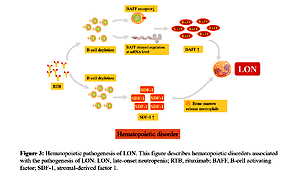Current issue
Archive
Manuscripts accepted
About the Journal
Editorial office
Editorial board
Abstracting and indexing
Subscription
Contact
Ethical standards and procedures
Most read articles
Instructions for authors
Article Processing Charge (APC)
Regulations of paying article processing charge (APC)
HEMATOLOGY / STATE OF THE ART PAPER
An update on the incidence, risk factors and mechanisms of rituximab-associated neutropenia
1
Department of Nephrology, the Second Affiliated Hospital of Nanchang University, Nanchang, China
2
Department of Blood Transfusion, the Second Affiliated Hospital of Nanchang University, Nanchang, China
Submission date: 2022-05-15
Final revision date: 2022-07-10
Acceptance date: 2022-07-17
Online publication date: 2022-09-15
Arch Med Sci 2024;20(2)
KEYWORDS
TOPICS
ABSTRACT
With the increasing application of rituximab (RTB) in hematological diseases and autoimmune diseases (AIDs), we have gradually increased our awareness of the adverse reaction of rituximab-associated neutropenia (RAN), but little is known about its true incidence rate, susceptibility risk factors and exact pathogenesis. At present, research groups have conducted a large number of studies on different populations. The team found that age (> 60), advanced disease, systemic lupus erythematosus (SLE) and combined cyclophosphamide therapy were independent risk factors for RAN. However, its exact mechanism is not completely clear. Several hypotheses have been put forward to solve this question, including the production of anti-neutrophil antibodies after RTB, the generation disorder and neutrophil maturation stagnation caused by abnormal B-cell reconstruction, and the amplification of T-large granular lymphocyte population that may induce neutrophil apoptosis. However, there are still many unsolved problems in all aspects of RAN. This article is an update of the incidence rate, risk factors and mechanisms of RAN.
Share
RELATED ARTICLE
We process personal data collected when visiting the website. The function of obtaining information about users and their behavior is carried out by voluntarily entered information in forms and saving cookies in end devices. Data, including cookies, are used to provide services, improve the user experience and to analyze the traffic in accordance with the Privacy policy. Data are also collected and processed by Google Analytics tool (more).
You can change cookies settings in your browser. Restricted use of cookies in the browser configuration may affect some functionalities of the website.
You can change cookies settings in your browser. Restricted use of cookies in the browser configuration may affect some functionalities of the website.



